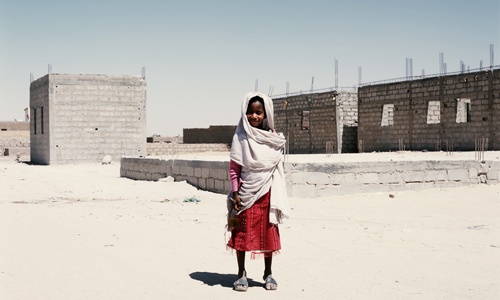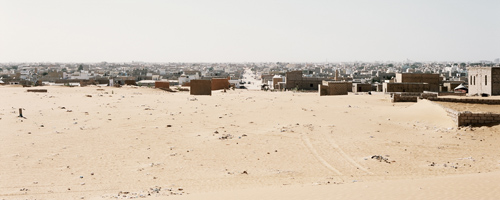Christian Vium
April 2011
Back in Nouakchott, Mauritania
I have been back for some time here in Nouakchott now, following up on the first field-work in 2009/2010. In particular, I am extending the case-studies with my informants in Toujounine, while delving even more into the Aftout Essahli project, which has now become partly operational. Water is flowing at a higher speed, and with more stability – which is good news for the inhabitants of Toujounine, who experience stable water prices compared to earlier.

One of the families I have been following here have acquired themselves a small TV and a satellite disk, and together with several of the neighbouring families they have payed to have electricity installed. So, I have seen how the news of the death of Ossama Bin Laden have travelled the world, marvelled at the spectacle of the Royal wedding of Prince William and Kate Middleton and been subjected to endless streams of dramatic Middle Eastern soap operas – all in a tent on the outskirts of Nouakchott. I am continuing my video- and photographic documentation, and have almost finished mapping the periphery of Nouakchott with GPS and large-format images – something I think will come in handy in the future. Yesterday I photographed a boy who looked at me as if I was a ghost, and when I asked him whether he had never seen a white man he shook his head in terror. At the improvised football pitch on one of the last pieces of land that hasn’t already been occupied, boys are sporting FC Barcelona, Real Madrid and Chelsea FC shirts in the late afternoon hours, while houses spring up everywhere. Nouakchott resembles a huge construction site and the changes since last year are phenomenal. On one of my many photo-mapping exhibitions, I went back to a neighbourhood known as Kosovo, and it was hardly recognizable. Roads are being built, and entire neighbourhoods emerge from the sand.
The family I have been following most closely in Boh Dida, has learned that their plot is safe from harm in terms of the ongoing urban restructuration process initialized by the government, and with a little luck, they will be able to claim the plot and sell it to one of the business men scouting in the area. With the money, Leile, the mother, will be able to pay for her three children’s school and buy a new plot a bit further away and start constructing a simple house.

Meanwhile, more young men have moved into the one-room house where some of the water vendors I have been working with are sleeping. Some of those who have been in the city for years have bought used Mercedes 190s, and are now working as taxi drivers, leaving the hard physical work of water transportation to the younger men.
At the municipal office, my main informant Begnoug is juggling endless demands and expectations from a multitude of actors – still seemingly without stress. He has been elected chef du tribu, since his father passed away, so he now has even more obligations to live up to.
At the CUN, people are preparing for elections – the president of the CUN looks like a potential opponent to the Head of State, Ould Aziz, and this means political negotiations between the ministries controlled by Ould Aziz on the one hand, and the CUN on the other, are further complicated.
There haven’t been kidnappings for a while, and here in Nouakchott it feels safe, although the expat community shows obvious signs of fear in the face of uncertainty over what the future will bring.
Look forward to seeing you soon
AFRICA IS THE FUTURE
Christian
Februar 2010
Urban Assemblages and Constipated Metabolisms
-letter from Nouakchott, The Islamic Republic of Mauritania
Nouakchott, the windblown capital in the Islamic Republic of Mauritania, ranks among the fastest growing cities on the southern hemisphere. Over the last five decades since it was constructed ex-nihilo in the wake of independence from the French Colonial Authorities in 1960, the city has grown from a small settlement of some 500 inhabitants into a 30 by 20 kilometre urban assemblage, home to nearly 1 million souls – which amounts to about one third of the total population of the country. This extraordinary growth has been largely catalysed by the Great Sahelian droughts in the early 1970s and mid 1980s, which decimated the herds of nomadic pastoralists throughout the southern fringes of the Sahara and particularly in the Sahel zone which stretches from West to East across Africa. While this so-called ”rural exodus” has levelled out in later years, the influx is still high and hundreds of people arrive each day in this magnet of hope.
I am here to investigate the city from the point of view of sedentarised nomads, by looking into ways in which the ”urbanophobe” archetype – the nomad - produces the city through a complex set of tactics which manifest themselves in the porous or ’holey’ (peri)urban space, that arise in the interface between the state and informal agents of various kinds.

So far, my work is centred around the urban municipality of Toujounine, on the eastern fringes of the city, where most of those nomads who originate in the eastern parts of the country have settled down over the last three to four decades. Toujounine consists mainly of informal settlements on state-owned land, and due to the seemingly anarchic occupation of land, infrastructure such as road- and waternetworks are limited. Approximately 90 percent of the municipality do not have running water, and are dependent on water vendors for their water. Throughout the municipality, privately-owned water hydrants provide water to the mobile water vendors, who transport the water out to private households. Due to the dilapidated nature of the waternetwork, water is scarce, and cuts to the flow of water are common.
So far, I have been working with a group of water sellers (all sedentarised nomads originating in the East) operating from a hydrant in Boh Dida, one of the poorest and least developed neighbourhoods in Toujounine in terms of infrastructure. Speculation is land is extreme, and the government is in the process of large-scale projects to restructure the area, clearing land for roads, preparing waterpiping, electricity, etc. etc. In order to follow this important process, I am working with a small handful of local families, all sedentarised nomads from the eastern provinces, who are trying to navigate this dynamic landscape through ingenious short-term tactics and long-term strategies which seem to be very much prolongations of the nomadic strategies employed in the desert. I am seeing continuity rather than rupture in this sense so far.
In addition, I have been working closely with the Director of the Technical Services at the Municipial Office, who is himself the son of a nomadic chief in Southeastern Mauritania. On the top-end of the hierarchy, I have met with representatives of the National Water Services, as well as the Communauté Urbaine de Nouakchott (CUN) who are coordinating the infrastructural developments in the nine urbain municipalities that make up the city of Nouakchott. One of the things I am looking into is the planning and implementation of the largest development project in Mauritania since the early 1980s – the Aftout Es Sahli Project, which is projected to triple the provision of potable water in Nouakchott within the next five years. This massive infrastructural project enables the caption of water from the River Senegal, some 200 kilometres south of Nouakchott and is transportation and cleansing in two large pipes which are currently under construction. I have visited the project on a number of occasions and it is truly fascinating.

Everything is progressing really well, I have been collecting a lot of visual data in the forms of video recordings, photographs and maps and have started going through the archives down here. They are in a lamentable condition, but nevertheless, interesting things are emerging.
In short, things are taking shape, and I am starting to see some kind of logic in these complex amalgamations of socio-technical infrastructures, informal and formal political negotiations and socio-cultural mutations.
Best Regards from Nouakchott.
Christian Vium
